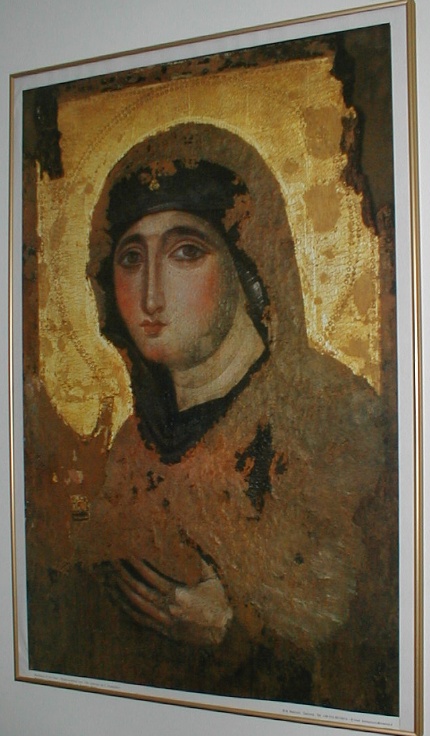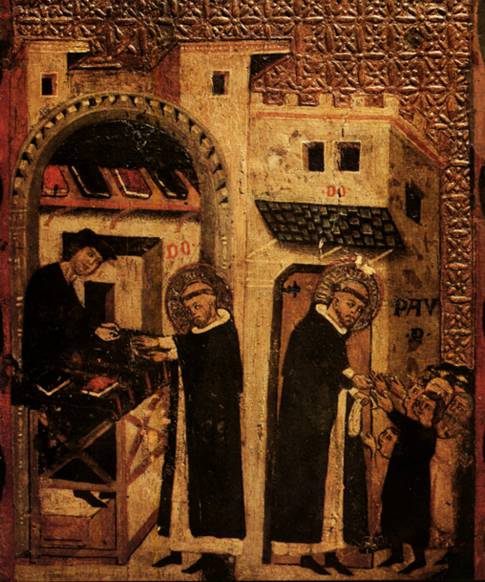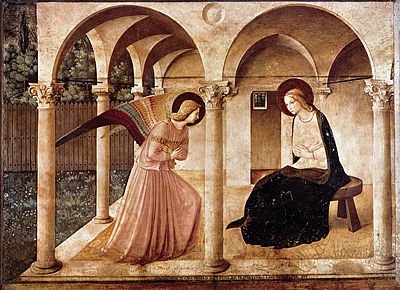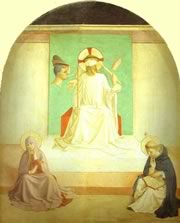|
|
Dominican Art

The Miraculous Image of the Madonna of San Sisto
 Dominican
Saints Surrounding the Crucified Christ Dominican
Saints Surrounding the Crucified Christ

St Dominic

St Dominic Meditates

Saint Dominic Sells His Books

St Dominic Walking

Fra Angelico

Annunciation by Fra Angelico

Annunciation
Fra Angelico demonstrates his understanding of linear perspective
particularly in his Annunciation paintings. This large fresco stands at the top
of the stairway leading to the cells of the monks in the Dominican Monastery
Museum of San Marco Florence, Italy
[Return to Top]

A painting of Dominican saints surrounding a
crucified Christ by Sister Mary of the Compassion, Union City. The life-size
painting (8 by 4 feet) is currently housed at the Dominican House of Studies in
Washington, D.C.
[Return to Top]
 The Miraculous Image of the Madonna of San Sisto The Miraculous Image of the Madonna of San Sisto
Before the masterful frescoes of Blessed Fra Angelico graced the cloister of
San Marco, the Order of Preachers (Dominicans) possessed an artistic work of
great character and heritage in the miraculous image of the Madonna of San Sisto
in Rome, Italy.
This icon of Our Lady was thought during the Middle Ages to have been designed
by Saint Luke the Evangelist and to have been painted by angels. Legend held
that a holy man from the East brought it to Rome. There it was acquired by three
brothers who were exiles from Constantinople, presumably because their adherence
to orthodox Christianity, ran into conflict with an outbreak of monophysitism or
iconoclasm. The image was placed in the Church of Santa Agata in Turn outside
the Appian Way, which, in honor of the icon, became known as alternatively,
Santo Maria in Turn and Santa Maria in Tempulo. Confirming parts of this
medieval legend, modern historical study has indicated that this Madonna is of
Byzantine origin and was venerated at least by the end of the fifth century.
When Saint Dominic was charged by Pope Honorius III to establish a reformed
community of nuns at San Sisto in Rome, one of the communities from which nuns
were voluntarily drawn was the monastery at Santa Maria in Tempulo. St. Dominic
lavished his attention upon the nuns of Santa Maria, preaching to them and
giving them spiritual direction. It was to each of these same women in 1219 that
St. Dominic brought wooden spoons which he had carried on a journey from Spain.
At that same time, he received the promise of the nuns that they would enter the
new community of San Sisto. However, the mere possibility of the nuns moving
from their monastery into a stricter community caused their relatives and
friends to protest vociferously. After further entreaties from St. Dominic, most
of the nuns agreed to join the new community of San Sisto.
The nuns placed one caveat on their promise: that the miraculous image of the
Madonna in Santa Maria in Tempulo should also come with them. This was no
ordinary request. Legend had it that in the tenth century Pope Sergius III tried
to move the painting into the John Lateran Church, but it had returned
miraculously to its original home. God seemingly wanted the painting to remain
in Santa Maria in Tempulo.
St. Dominic was not daunted by the challenge. On the First Sunday of Lent,
February 28, 1221, Our Holy Father gave the habit and received in his hands the
profession of the nuns entering San Sisto. During the following night, St.
Dominic carried the miraculous image of the Madonna to its new home at San Sisto.
The painting did not fly back on its own accord, thus bestowing the divine seal
of approval to St. Dominic's foundation.
The miraculous Madonna remained at San Sisto until 1575, when it was transferred
to San Dominico and Sisto on the Quirinal where the nuns had relocated upon the
urging of Pope Saint Pius V. After the monastery became the home of the
Angelicum, the image was under the care of the Dominican friars for a time. In
1931, however, the image was placed in Santa Maria del Rosario e della Febbre a
Monte Mario where the nuns had moved into a new monastery. The image was
restored by Dr. Carlo Bertelli in the 1950's.[Return
to Top]
 Oldest
image of Saint Dominic by an unknown 14th
century artist - located in the Priory of the Basilica of San Domenico in
Bologna, Italy Oldest
image of Saint Dominic by an unknown 14th
century artist - located in the Priory of the Basilica of San Domenico in
Bologna, Italy

Saint Dominic
Sells His Books
"And when Saint Dominic saw that great famine was there, he
sold his books, and all his substance, and gave the price of them to poor
people."
[Return
to Top]

St Dominic Meditates by Fra
Angelico - In a particularly haunting depiction of the mocking of Christ,
the blindfolded Savior is beset by a swarm of disembodied hands, while in the
foreground sit the Blessed Mother, lost in private meditation, and St. Dominic,
contemplating an open book in his lap. For Fra Angelico the religious life was a
life lived in the presence of Christ and emotionally engaged in the ongoing
drama of redemption.]

St Dominic Walking
 [Return
to Top] [Return
to Top]
Fra
Giovanni da Fiesole (Fra Angelico), a Dominican friar, was perhaps the
most important painter of Renaissance Florence. He was born Guido di Pietro in
Mugello, Italy, and began the significant part of his career at the Dominican
monastery at Fiesole.
While his early panels of triptych altarpieces are
indebted to traditional Sienese practice, he was already highly aware of the
innovations of Florentine art. His "Annunciation" of about 1432-not to be
confused with the later fresco-shows the development of an individual style,
mixing an assertively Florentine sense of perspective with graceful proportion
and restraint.
Living largely in a state of withdrawal from the world, Angelico presided over a
busy workshop in the Dominican Observant house at Fiesole.
His worldly fame and reputation meanwhile
grew rapidly, partly because-in contrast perhaps to his devotional modesty-his
works were strenuously adventurous and advanced, with daring degrees of
compositional freedom. In the late 1430's, after the shop had moved to the S.
Marco monastery in Florence, Angelico made great strides in the use of color,
form, and perspective. Instead of showing saints, angels, and a Madonna on
separate panels, the central panel of a 1438 altarpiece-commissioned by Cosimo
del Medici-surrounds the Madonna with angels and saints, an approach that
entered the vocabulary of Renaissance composition as "sacra conversazione". In
works of the early 1440's, a realistic and exciting sense of panoramic space
pervades Angelico's pictures, as do delicate and subtle uses of color to express
distance and variation in light. His best known and perhaps most thoroughly
timeless work is from the series of frescoes he painted in S. Marco monastery,
mainly in the early 1440's. Some of those frescoes-the "Annunciation", for
example-were painted in the public spaces, as aids to group devotion; others
were painted in private cells.
In 1447, having been called to Rome, Angelico and his workshop assistants made a
richer and even more ambitious set of frescoes for walls and ceilings in the
private chapel of Pope Nicholas V. Having served as Prior of S. Domenico in
Fiesole, Angelico returned to Rome, where he died. Legend tells us that Fra
Angelico never took up his brush to paint without first making a prayer. To
behold the luminosity of his work convinces us this must be true and further,
that the act of painting itself was prayer. He hoped in his works to evoke
feelings of devotion to God in all who saw them
[Return to Top]
- CREATIVE PREACHING THROUGH ART:
-
THE DOMINICAN CONTRIBUTION
Eleanor Carlo, T.O.P
These addresses were presented at an Annual
Dominican Family Awareness Day held at Providence College, Providence, Rhode
Island, in March, 1978. They are offered to all the members of the Dominican
Family through the cooperation of the Dominican Laity in the Provinces of
St. Joseph and St. Albert the Great, U.S.A.
Dominicana Publications, 1979.
This
paper offers a brief summary of a slide-lecture Workshop prepared for
Dominican Family Awareness Day. Its thrust is the unique ministry of gifted
Dominicans who responded to their vocation by creatively, effectively and
compellingly enhancing and`supplementing the preaching of the Word of God --
plus a challenge for us today.
It is a well-known fact that, among its members, the Order of Preachers
has contributed some distinguished artists and architects. That it has also
been responsible for recognizing and commissioning some of the greatest
talents of all time is another fact with which art historians and art lovers
are well-acquainted.
Preaching and religious art are related
in that each is concerned with communicating truth and beauty.
Preaching and religious art are related in that each is concerned with
communicating truth and beauty. Since Dominicans are called to preach the
truth and beauty of the Catholic faith, not only by word and example, but in
every possible way, it follows that if one happens to be an artist in the
Dominican Family, he will endeavor to lead others to God through his art. As
St. Catherine of Siena relates in her "Dialogues" there are many roads and
ways which God uses through His Love to lead people to Him. Art is the way
of beauty, a road which leads directly to Him, if we are so blessed as to be
led along this road.
Because their inspiration comes from God, the preacher and the artist
communicate with a sense of mission. Mission implies the giving of self --
and the motive of mission is Love. Artists are ardent preachers who have
been inspired by God and have been given gifts for interpreting the Gospel
and spiritual reality. Fra
Angelico and Fra Bartolomeo are among those who point out things we often
fail to see without their help. A more recent artist-preacher who has made
visible for us the invisible (invisible that is except to Lucy, Francesco
and Jacinta) is the late sculptor, Father Thomas McGlynn, O.P. How grateful
we are to him to have his representation of Lucy's description of her vision
of Our Lady of Fatima -- made visible to us through his Labor of Love!
Art is the way of beauty,
a road which leads directly to Him
And what of the well-loved painting of Fra Angelico in which St. Dominic
appears meditating on the Passion in "The Buffeting of Christ"? Doesn't that
penetrate far more deeply into our hearts and minds than descriptive words,
happy as we are to have them? The greatest masterpieces are in reality
sermons on canvas or stone. They are created to dispose us to prayer. They
have the capacity to arouse us from an attitude of indifference to deepest
compunction or to a sense of the sublime. We come away from them ennobled
and enriched.
Dominican art is marked by the strong influence of St. Dominic's
spirituality, the Order's theological emphasis of preaching truth and
fighting heresy, as well as the contributions of such distinguished
authorities as St. Thomas Aquinas, St. Antoninus, and Savonarola. Through
its special devotions to the Body of Christ, to our Lady, St. Catherine of
Siena, and other illustrious saints, it has enriched the iconography of the
world of art. Reflected in formal beauty and style, purity of expression and
jewel-like color are the following qualities of art for St. Thomas:
integrity, proportion, harmony, and splendor. The universally admired
Dominican contributions to Christian artistic expression are our legacy, our
heritage, --ours for the looking! Ours for the challenge of today's call and
response.
Since this workshop is intended to be participatory, you will want to
know just how you are expected to participate. Your share is to do something
very much in keeping with the Dominican call and its response, i.e., to
contemplate the slides which are to be projected on the screen, and to share
the fruits of your contemplation with others by contributing your insights
and appreciations. You will be shown works created by Dominican artists or
commissioned under the auspices of Dominican patronage, influence, and
inspiration -- Duccio, Albertinelli, Masaccio, Botticelli, Lippi, Raphael,
Fra Angelico, Leonardo da Vinci, Michelangelo, to name a few. They are works
of great beauty in style, in message, in spiritual depth. They have a
special quality about them, not only because they were created by experts in
their field, but because they were created in many cases by men who had
trodden the mystical path themselves. Even though their voices are long
still, they continue to preach with an artist's passion, and are able to
nourish us today.
You are asked to relax and to enjoy them
Serenely, because you are called to contemplation,
In order to make the artist-preacher's art a meaningful experience, it is
necessary to develop a contemplative approach. In viewing these slides, you
are asked to relax and to enjoy them serenely, because you are called to
contemplation. "Contemplation," Evelyn Underhill tells us in her book on
Practical Mysticism," ...is the necessary activity for all artists. The
artist is a contemplative who has learned to express himself, and who tells
his love in color, line, and form. He tries to express something of the
revelation he has received through his experience and understanding. He
wants to communicate to you a glimpse of what he, himself, has grasped."
Just how do artists contribute to our understanding of spirituality? Is
it really possible to depict what eye hath not seen? The religious artist
agonizes over his effort to communicate to us his life of faith. How
successful he is is in large measure in direct proportion to our receptivity
to what he has produced, and to the extent that we allow God to speak to us
through the medium of His created works.
After contemplation, through love,
we are called to action.
St. Thomas Aquinas's belief in the importance of the image, that there is
no thinking without the use of images or symbols, should continue to have
great significance for the power, prestige, and practice of art within the
Dominican Order today. This includes contemporary art forms such as
graphics, photography, and film. The incredible possibilities of reaching
untold "congregations" of captive television audiences for Christian
Communication by preachers and artists working together in the spirit and
zeal of St. Dominic but in today's idiom and imagery holds mind-boggling
possibilities of making God's world televisible. "Images," says St.
Thomas, "necessarily accompany our knowledge in this present life, however
spiritual the knowledge may be, for even God is known by us through the
images of His effects."
|









